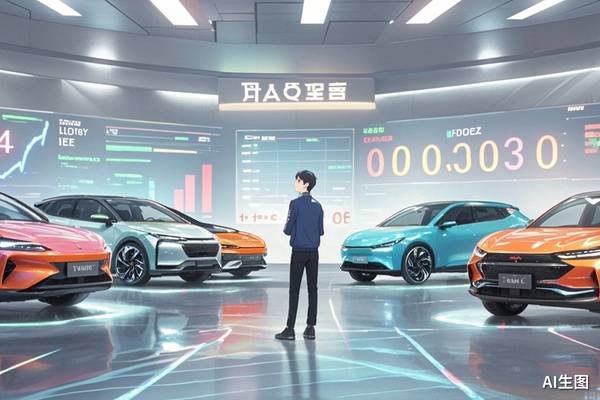The automotive market in September this year was unusually bustling. When looking at the new car calendar for September, it seemed as if all major automakers had made an appointment to bet their most important products on this month. Scrolling through the Moments on WeChat, one could see the new car press conferences of certain brands every now and then. Flipping through the push notifications of automotive media, there was almost a “blockbuster launch” headline every week.
It’s not something new that there are many new cars in September, but this year it was really extremely crazy: Fangchengbao Titanium 7 was launched in the early part of the month, and the number of deliveries exceeded 1,000 within 5 days of its launch; Jihu T1, in the pure – electric small car market, received over 26,000 large – scale orders within 1 hour of its launch; Xingjie S9T was launched as the first station wagon under Hongmeng Zhixing, followed by the new Wenjie M7 and the highly anticipated Shangjie H5; Audi E5 Sportback, Lynk & Co 10 EM – P, Denza N9, and Zeekr 9X also launched one after another.
According to incomplete statistics, in the whole of September, more than 30 new cars, including both fuel – powered and new – energy vehicles, were launched. Even the media said, “There aren’t enough automotive media reporters.”
Before the arrival of Q4, all major automakers seemed to have heard the same starting gun and placed all their chips on this starting line. There are multiple reasons behind this. On the one hand, the approaching expiration of the policy window is a factor. The constant urging of the annual KPIs also cannot be ignored. All automakers have been involved in a high – stakes race against time. The prosperity and pressure in the Chinese automotive market are clearly visible.
What made September this year different was, first of all, a clear deadline: The new – energy vehicle purchase tax exemption policy will expire at the end of this year. Starting from January 1st next year, it will be changed to “half – tax collection”, with a maximum tax reduction of 15,000 yuan per vehicle, and the preferential intensity will decline. For a new – energy vehicle worth 300,000 yuan, the purchase tax exemption means a real discount of nearly 30,000 yuan. This figure is enough to make many hesitant consumers make up their minds immediately.
History always repeats itself surprisingly. When the purchase tax exemption policy was about to expire for the first time at the end of 2022, there was also a surge in deliveries across the industry. The experience from that time taught all automakers that the policy window period is the period of explosive sales. Now, the same window has opened again, and there are only 100 days left.
For automakers, it usually takes 1 – 2 months of market cultivation and production capacity ramping up from the launch of a new car to large – scale delivery. This means that if a new car is launched in September, deliveries will start in October, and full – scale efforts will be made in November and December. Consumers can just pick up their cars before the end of the year and enjoy the last purchase tax exemption. So why was the density of new car launches in September this year much higher than in previous years? It may not be that automakers have become more diligent. It’s just that the policy countdown has compressed all the new cars that might have been launched gradually in Q4 into September, the last starting line. One day’s delay means one day less of the sales window, and one week’s delay might mean selling thousands of cars less.
It should be noted that the purchase tax exemption policy is not based on the date of signing the car purchase contract, but on the date of invoice issuance. This means that to enjoy the purchase tax exemption, it is necessary to ensure that the issuance date of the invoice or relevant valid vouchers when buying the car is within the tax – exemption period stipulated by the policy.
Therefore, placing an order before the end of the year is definitely not enough. Sufficient time also needs to be set aside to complete the procedures, obtain the invoice, and enter the production scheduling (usually getting a clear vehicle frame number). This is why Li Auto and NIO have successively promised that if users cannot enjoy the purchase tax exemption according to the existing policy due to production scheduling reasons, they will bear the difference.
In addition to these reasons, the traditional concept of “Golden September and Silver October” still plays a role in promoting the automotive market this year, which also indirectly speeds up the pace of automakers to launch new models during this period. It should be said that the traditional concepts of “Golden March and Silver April” and “Golden September and Silver October” in the Chinese consumer market have long been deeply engraved in the DNA of all industries, including the automotive industry. Whether it’s buying a house or a car, or looking for a job or recruiting talent, people like to seize these time points.
Every September, along with the upcoming Mid – Autumn Festival and National Day holidays, consumers’ willingness to buy cars will be released intensively. New cars receive the highest attention and generate the most topics when they are first launched. Launching new cars at this time can take advantage of the traffic and atmosphere of the holidays to quickly build market awareness. Consumers can also take advantage of the holidays to visit car dealerships, test – drive cars, and place orders. Automakers may have planned this set of operations before the new car launch. This year, the National Day and Mid – Autumn Festival holidays overlap, creating a super – long 8 – day holiday, which makes automakers even more reluctant to miss such a golden time.
Judging from the information disclosed by various automakers during the National Day holiday, the National Day Golden Week really helped increase the footfall in shopping mall stores and 4S stores. Some automakers also showed good sales data and order – placing performance in the first week of October. The strategies of automakers have achieved certain results.
September also plays an important role as the last month of the third quarter and the starting line of the fourth quarter. For all automakers, this is a crucial time node. Whether the annual sales target can be achieved depends on this final quarter, Q4.
Hongmeng Zhixing hopes to complete the production capacity ramping up before the end of the year through the Xingjie S9T and a combination of new products; Fangchengbao under BYD launched the Titanium 7, entering the domestic SUV market with a starting price of 179,800 yuan. Even BYD, which has firmly held the top sales position, needs to consolidate its leading advantage before the end of the year. These goals carry the expectations of the capital market, the cost sharing of the supply chain, and the annual assessment of the dealer rebate policy.
Launching new cars in September can leave a three – month sales window for Q4, and this rhythm is just right. In the current highly competitive stock market, it’s difficult to make a breakthrough with old models. Only new products can open up new growth space. The concentrated manifestation of the annual strategies of automakers this time is to boost Q4 with new products and end the whole year with the results of Q4. What’s different this year is that when combined with the strong stimulus of the purchase tax countdown, the influencing factors are superimposed, making September this year an absolute window period that one has to seize.
When the policy node becomes the guiding stick for the collective actions of the industry, the volatility and uncertainty of the market are also increasing. In the past, a model could be popular for three years, but now it needs to be updated every six months. In the past, new car launches could be planned calmly, but now they must be launched on schedule. The biggest challenge for automakers in this wave of new car launches is the soaring marketing cost. All brands are launching new cars, holding press conferences, and running advertisements at this node, and consumers’ attention is severely diluted. Tens of millions are invested in a press conference, but the buzz may soon be drowned in the flood of information.
At the same time, production capacity and the supply chain are also under test. Launching new cars in September means that inventory needs to be stocked up from August to September, which places extremely high requirements on the response speed and production capacity planning of the supply chain. Fangchengbao Titanium 7 started deliveries right after its launch, and Xingjie S9T announced that it would start deliveries on September 21st. This is a tough battle for the manufacturing system.
An even deeper problem in this wave of new car launches is differentiation. When there are too many new cars on the market at the same time, how can one tell a different story? Every brand is trying to find its own positioning because in this homogenized competition, “I also have it” is no longer enough. It has to be “Only I have it”. For ordinary consumers, the choices have never been so abundant, but the decision – making pressure has also never been so great. With the overwhelming product promotions, it has become a difficult problem to find the truly suitable product under time pressure. The purchase tax countdown is like an invisible hourglass, and this sense of urgency may also make some people make less – than – rational choices in a rush.
When all automakers start at the same window period, this game is no longer about who runs fast, but about who won’t fall during the sprint. The new car feast in September is still going on. The intensive launch rhythm tests the real product strength and the resilience of the supply chain. Time will eventually prove who are the real long – distance runners and who are just sprinters pushed by the policy.
This article is from the WeChat official account “Cheyun” (ID: cheyunwang), author: YZLX, editor: Lu Zhiyao. It is published by 36Kr with authorization.
该文观点仅代表作者本人,36氪平台仅提供信息存储空间服务。
36kr Europe (eu.36kr.com) delivers global business and markets news, data, analysis, and video to the world, dedicated to building value and providing business service for companies’ global expansion.
© 2024 36kr.com. All rights reserved.



















